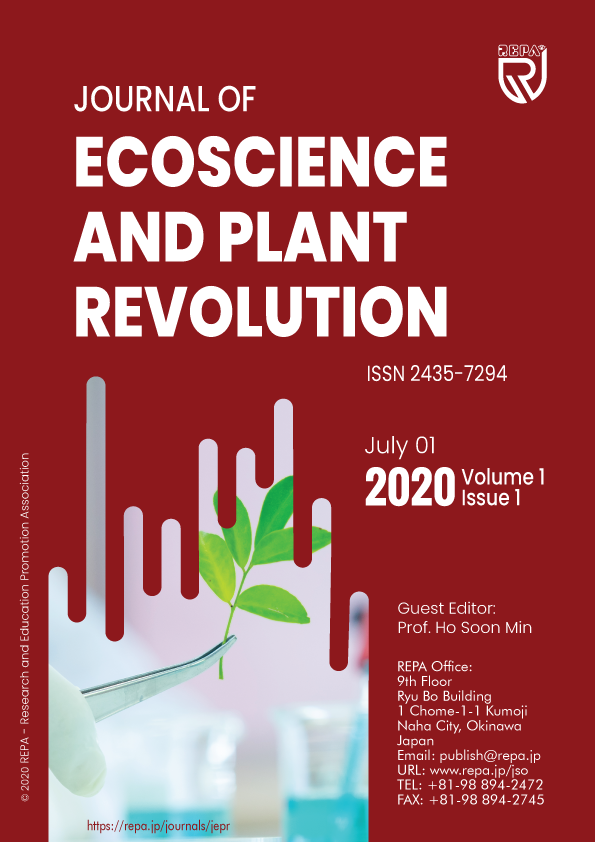⇒ Volume Number: 01
⇒ Issue Number: 01
⇒ Available Online: June 30, 2020
⇒ Volume Editor: Prof. Ho Soon Min, INTI International University, Malaysia
⇒ Issue Editor: Dr. Puneeta Paney, Central University of Punjab, India
⇒ Language and Proofreading Editor: Prof. Emil Chuck, George Mason University, USA
⇒ Copyeditor: Ms. Barnes K. and Ms. Sarah A., Research and Education Promotion Association (REPA), Japan
⇒ Administrator: Ms. Michell Ann., Research and Education Promotion Association (REPA), Japan
Journal Article (Special Issue) Open Access Published
Effect of harvesting stages and postharvest treatments on shelf life and quality of tomato (Lycoper-sicon esculentum Mill. var. Pearson) stored under ZECC condition
Hakimi SS, Dubey N, and Saharawat YS.
Journal of Ecoscience and Plant Revolution, 2020, 1 (1): 1-8 DOI 10.37357/1068/jepr.1.1.01
Tomato (Lycopersicon esculentum Mill) is one of the important commercial high value crops of Afghanistan. Among the different local varieties grown in Afghanistan, the “Pearson” variety is most popular because of its good commercial value due to its uniform globe shape and medium to large size. The study is conducted to understand the effects of different harvesting stages and postharvest treatments on the shelf life and postharvest quality of tomatoes (Pearson variety) stored under the Pusa Zero Energy Cool Chamber (ZECC) at the research farm of Agriculture Faculty, Kabul University. This is the first time that ZECC is introduced in Afghanistan for enhancing fruit shelf life. The standard dimension ZECC was built with 165 x 115 x 67.6 cm dimensions. After harvesting tomatoes at different maturity stages (Turning, Pink, and Light red color stages), fruits were precooled, graded, and treated with different concentrations of CaCl2 and mint leaf extract solutions. Thereafter, the tomatoes were placed in plastic baskets and stored in the Zero Energy Cool Chamber. During storage period, Total Soluble Solids (TSS, 0brix), pH, firmness (gr cm-2), shelf life, pericarp thickness (mm), fruit volume (cc), and fruit density were recorded. Two factorial CRD design was considered with harvesting stages as the first factor and postharvest treatments as the second factor. The data revealed that the shelf life of tomatoes was extended up to 29 days under T2 (turning color fruits treated with 6% CaCl2) and followed by T8 (turning color fruits treated with 6% CaCl2 + 6% mint Leaves extract) up to 28 days. Under T2, quality parameters such as TSS and pH increased from 3.85%brix and 2.85 to 4.4 0brix and 3.4, respectively. Firmness, pericarp and volume decreased from 1750 grcm-2, 0.75cm and 135 cc to 840 grcm-2, 0.67cm and 127 cc, respectively. At the last observation, density remained unchanged (1.00 gr/cc). In conclusion, tomatoes harvested at the turning-color stage treated with 6% CaCl2 and followed by 6% CaCl2 + 6% mint leaves’ extract had a significant effect on the enhancement of shelf life and quality of tomatoes under ZECC condition.
REPA
Hakimi SS, Dubey N, Saharawat YS (2020) “Effect of harvesting stages and postharvest treatments on shelf life and quality of tomato (Ly- copersicon esculentum Mill. var. Pearson) stored under ZECC condition” Journal of Ecoscience and Plant Revolution (vol. 1, no. 1, pp. 1–8) https://doi.org/10.37357/1068/jepr/1.1.01
APA
Hakimi, S. S., Dubey, N., & Saharawat, Y. S. (2020). Effect of harvesting stages and postharvest treatments on shelf life and quality of tomato (Ly- copersicon esculentum Mill. Var. Pearson) stored under ZECC condition. Journal of Ecoscience and Plant Revolution, 1(1), 1–8. https://doi.org/10.37357/1068/jepr/1.1.01
MLA
Hakimi, Sayed Samiullah, et al. “Effect of Harvesting Stages and Postharvest Treatments on Shelf Life and Quality of Tomato (Ly- Copersicon Esculentum Mill. Var. Pearson) Stored under ZECC Condition.” Journal of Ecoscience and Plant Revolution, vol. 1, no. 1, 2020, pp. 1–8, doi:10.37357/1068/jepr/1.1.01.
Vancouver
Hakimi SS, Dubey N, Saharawat YS. Effect of harvesting stages and postharvest treatments on shelf life and quality of tomato (Ly- copersicon esculentum Mill. var. Pearson) stored under ZECC condition. J Ecosci Plant Rev. 2020;1(1):1–8.
Chicago
Hakimi, Sayed Samiullah, Neeru Dubey, and Yashpal Singh Saharawat. 2020. “Effect of Harvesting Stages and Postharvest Treatments on Shelf Life and Quality of Tomato (Ly- Copersicon Esculentum Mill. Var. Pearson) Stored under ZECC Condition.” Journal of Ecoscience and Plant Revolution 1 (1): 1–8. https://doi.org/10.37357/1068/jepr/1.1.01.
Elsevier
Hakimi, S.S., Dubey, N., Saharawat, Y.S., 2020. Effect of harvesting stages and postharvest treatments on shelf life and quality of tomato (Ly- copersicon esculentum Mill. var. Pearson) stored under ZECC condition. J. Ecosci. Plant Rev. 1, 1–8. https://doi.org/10.37357/1068/jepr/1.1.01
IEEE
- S. Hakimi, N. Dubey, and Y. S. Saharawat, “Effect of harvesting stages and postharvest treatments on shelf life and quality of tomato (Ly- copersicon esculentum Mill. var. Pearson) stored under ZECC condition,” J. Ecosci. Plant Rev., vol. 1, no. 1, pp. 1–8, 2020, doi: 10.37357/1068/jepr/1.1.01.
Springer
Hakimi, S.S., Dubey, N., Saharawat, Y.S.: Effect of harvesting stages and postharvest treatments on shelf life and quality of tomato (Ly- copersicon esculentum Mill. var. Pearson) stored under ZECC condition. J. Ecosci. Plant Rev. 1, 1–8 (2020). https://doi.org/10.37357/1068/jepr/1.1.01.
Sayed Samiullah Hakimi
Department of Horticulture, Faculty of Agriculture, Kabul University, Kabul, Afghanistan
Neeru Dubey
Amity International Centre for Post-Harvest Technology and Cold Chain Management, Faculty of Horticulture, Amity University, Noida, Uttar Pradesh, India
Yashpal Singh Saharawat
Department of Soil Science and Agriculture Chemistry (SSAC), Department of Soil Science, Indian Agricultural Research Institute, New Delhi, India
-
Agriculture Statistic Department (2017) Ministry of Agriculture, Irrigation and Livestock (https://www.mail.gov.af/en) Accessed: 1 November 2019
-
Saraswathy S, Preethi TL, Balasubramanyan S, Suresh J, Revathy N, et al. (2008) “Postharvest management of horticultural crops,” 1st ed. Rajasthan, India, Agrobios (India). 577 p. ISBN: 978-81-7754-322-3
-
Arthur E, Oduro I, Kumah P (2015) “Postharvest Quality Response of Tomato (Lycopersicon Esculentum, Mill) Fruits to Different Concentrations of Calcium Chloride at Different Dip- Times” American Journal of Food and Nutrition (pp. 1–8)
-
Al-Sum BA, Al-Arfaj AA (2014) “Antimicrobial Activity of the Aqueous Extract of Mint Plant” Science Journal of Clinical Medicine (vol. 2, no. 3, pp. 110) https://doi.org/10.11648/j.sjcm.20130203.19
-
Moghaddam M, Pourbaige M, Tabar HK, Farhadi N, Hosseini SMA (2013) “Composition and Antifungal Activity of Peppermint (Mentha piperita) Essential Oil from Iran” Journal of Essential Oil Bearing Plants (vol. 16, no. 4, pp. 506–512) https://doi.org/10.1080/0972060X.2013.813265
-
A LB, Dv S, V B (2011) “Evaporative cooling system for storage of fruits and vegetables - a review.” J Food Sci Technol (vol. 50, no. 3, pp. 429–442) https://doi.org/10.1007/s13197-011-0311-6
-
Islam MP, Morimoto T, Hatou K (2012) “Storage behavior of tomato inside a zero energy cool chamber” Agricultural Engineering International: CIGR Journal (vol. 14, no. 4, pp. 209–217)
-
Islam MP, Morimoto T (2012) “Zero Energy Cool Chamber for Extending the Shelf-Life of Tomato and Eggplant” Japan Agricultural Research Quarterly: JARQ (vol. 46, no. 3, pp. 257–267) https://doi.org/10.6090/jarq.46.257
-
Abiso E, Satheesh N, Hailu A (2015) “Effect of storage methods and ripening stages on postharvest quality of tomato (Lycopersicom esculentum Mill) cv. Chali” Annals. Food Science and Technology 2015 Targoviste, Romania, Valahia University Press, vol. 16 - pp. 127–137. (https://pdfs.semanticscholar.org/9809/8738e65c315b8a4efc4c4adede4d821448ac.pdf?_ga=2.219181342.643294641.1587536878-321628801.1585267670) Accessed: 1 November 2019
-
Casierra-Posada F, Aguilar-Avendaño ÓE (2008) “Quality of tomato fruits (Solanum lycopersicum L.) harvested at different maturity stages” Agronomía Colombiana (vol. 26, no. 2, pp. 300–307)
-
Dhall RK, Singh P (2013) “Effect of Ethephon and Ethylene Gas on Ripening and Quality of Tomato (Solanum Lycopersicum L.) during Cold Storage” Journal of Nutrition & Food Sciences (vol. 3, no. 6, pp. 1–7) https://doi.org/10.4172/2155-9600.1000244
-
Dumas Y, Dadomo M, Lucca GD, Grolier P (2003) “Effects of environmental factors and agricultural techniques on antioxidantcontent of tomatoes” Journal of the Science of Food and Agriculture (vol. 83, no. 5, pp. 369–382) https://doi.org/10.1002/jsfa.1370
-
Parker R, Maalekuu B (2013) “The effect of harvesting stage on fruit quality and shelf-life of four tomato cultivars (Lycopersicon esculentum Mill)” Agriculture and Biology Journal of North America (vol. 4, no. 3, pp. 252–259) https://doi.org/10.5251/abjna.2013.4.3.252.259
-
Chepngeno J, Owino W, Kinyuru J, Nenguwo N (2016) “Effect of Calcium Chloride and Hydrocooling on Postharvest Quality of Selected Vegetables” Journal of Food Research (vol. 5, no. 2, pp. 23–40) https://doi.org/10.5539/jfr.v5n2p23
-
Senevirathna P, Daundasekera W a. M (2010) “Effect of postharvest calcium chloride vacuum infiltration on the shelf life and quality of tomato (cv. ’Thilina’)” Ceylon Journal of Science (Biological Sciences) (vol. 39, no. 1, pp. 35–44) https://doi.org/10.4038/cjsbs.v39i1.2351
-
Pinheiro SCF, Almeida DPF (2008) “Modulation of tomato pericarp firmness through pH and calcium: Implications for the texture of fresh-cut fruit” Postharvest Biology and Technology (vol. 47, no. 1, pp. 119–125) https://doi.org/10.1016/j.postharvbio.2007.06.002
-
Wu T, Abbott JA (2002) “Firmness and force relaxation characteristics of tomatoes stored intact or as slices” Postharvest Biology and Technology (vol. 24, no. 1, pp. 59–68) https://doi.org/10.1016/S0925-5214(01)00133-8
-
Moneruzzaman KM, Hossain ABMS, Sani W, Saifuddin M, Alenazi M (2009) “Effect of harvesting and storage conditions on the post harvest quality of tomato (Lycopersicon esculentum Mill) cv. Roma VF” Australian Journal of Crop Science (vol. 3, no. 2, pp. 113–121)
The author(s) has received no specific funding for this article/publication.
Journal Article (Special Issue) Open Access Published
Effect of cultural practices on quality and yield of onion (Allium cepa L. Var. Safid e Paisaye)
Salari H, Hansra BS, Saharwat YS.
Journal of Ecoscience and Plant Revolution, 2020, 1 (1): 9-14 DOI 10.37357/1068/jepr.1.1.02
Onion (Allium cepa L.) is among the most cultivated vegetable crops in the world. Afghanistan is thought to be the origin as several local and wild varieties are found in different parts of the country. Safid e Paisaye is a local variety grown in central parts of Afghanistan in the Ghorband valley. This variety has long storability and high market demand among restaurants in the region, but little research has been done to increase the quality and its availability to the market to increase its market share in Afghanistan. Conducted under supervision of Amity University Uttar Pradesh, Noida, India, at Agriculture Faculty Research Farm of Kabul University, this investigation looks at plough depth, land preparation methods, and planting date on quality and yield of onion bulb; it also studied other cultural practices including irrigation and fertilization dose and frequency. The parameters studied in this investigation include neck diameter (cm), bulb diameter (cm), neck to bulb ratio, bulb weight (gr), bulb volume (cm3), bulb density (gr/cm3), Total Soluble Solids (TSS) (Brix), firmness (Kg/cm2), marketable yield (MT/Ha), and total yield (MT/Ha). The data revealed that planting date has significant influence on bulb quality and yield of onion. The highest bulb diameter (6.95 cm), bulb weight (121 gr), bulb volume (128 cm3), marketable yield (32.54 MT/Ha), and total yield (34.24 MT/Ha) and the lowest neck to bulb ratio (0.04) were recorded for the first planting date (seed sown in nursery on 10 March - seedlings planted in field on 10 May). Land preparation methods only had significant influence on marketable yield; the highest marketable yield (26.90 MT/Ha) was recorded for flat bed land preparation method. Plough depth had no significant influence on onion quality and yield. Bulb density, TSS,and firmness were not significantly influenced by factors studied in this investigation. Conclusions: early sowing and planting of onion variety Safid e paisaye can significantly increase yield and productivity. Flat bed land preparation method is more suitable for higher productivity of onion variety Safid e Paisaye as compared to raised beds.
REPA
Salari H, Hansra BS, Saharwat YS (2020) “Effect of cultural practices on quality and yield of onion (Allium cepa L. Var. Safid e Paisaye)” Journal of Ecoscience and Plant Revolution (vol. 1, no. 1, pp. 9–14) https://doi.org/10.37357/1068/jepr/1.1.02
APA
Salari, H., Hansra, B. S., & Saharwat, Y. S. (2020). Effect of cultural practices on quality and yield of onion (Allium cepa L. Var. Safid e Paisaye). Journal of Ecoscience and Plant Revolution, 1(1), 9–14. https://doi.org/10.37357/1068/jepr/1.1.02
MLA
Salari, Hamid, et al. “Effect of Cultural Practices on Quality and Yield of Onion (Allium Cepa L. Var. Safid e Paisaye).” Journal of Ecoscience and Plant Revolution, vol. 1, no. 1, 2020, pp. 9–14. Zotero, doi:10.37357/1068/jepr/1.1.02.
Vancouver
Salari H, Hansra BS, Saharwat YS. Effect of cultural practices on quality and yield of onion (Allium cepa L. Var. Safid e Paisaye). J Ecosci Plant Rev. 2020;1(1):9–14.
Chicago
Salari, Hamid, B S Hansra, and Yashpal Singh Saharwat. 2020. “Effect of Cultural Practices on Quality and Yield of Onion (Allium Cepa L. Var. Safid e Paisaye).” Journal of Ecoscience and Plant Revolution 1 (1): 9–14. https://doi.org/10.37357/1068/jepr/1.1.02.
Elsevier
Salari, H., Hansra, B.S., Saharwat, Y.S., 2020. Effect of cultural practices on quality and yield of onion (Allium cepa L. Var. Safid e Paisaye). J. Ecosci. Plant Rev. 1, 9–14. https://doi.org/10.37357/1068/jepr/1.1.02
IEEE
- Salari, B. S. Hansra, and Y. S. Saharwat, “Effect of cultural practices on quality and yield of onion (Allium cepa L. Var. Safid e Paisaye),” J. Ecosci. Plant Rev., vol. 1, no. 1, pp. 9–14, 2020, doi: 10.37357/1068/jepr/1.1.02.
Springer
Salari, H., Hansra, B.S., Saharwat, Y.S.: Effect of cultural practices on quality and yield of onion (Allium cepa L. Var. Safid e Paisaye). J. Ecosci. Plant Rev. 1, 9–14 (2020). https://doi.org/10.37357/1068/jepr/1.1.02.
Hamid Salari
Department of Horticulture, Faculty of Agriculture, Kabul University, Kabul, Afghanistan
B.S. Hansra
Department of Horticulture, Amity Institute of Horticulture Studies and Research, Amity University, Noida, India
Yashpal Singh Saharwat
Department of Soil Science, Indian Agriculture Research Institute, New Delhi, India
-
Commodities by countries (2017) Food and Agriculture Organization (FAO) (http://www.fao.org/faostat/en/#rankings/commodities_by_country) Accessed: 1 November 2019
-
Mehta I (2017) “Origin and History of Onions” IOSR Journal Of Humanities And Social Science (vol. 22, no. 9, pp. 7–10)
-
Upadhyay DRK (2016) “Nutraceutical, pharmaceutical and therapeutic uses of Allium cepa: A review” International Journal of Green Pharmacy (IJGP) (vol. 10, no. 1, ) https://doi.org/10.22377/ijgp.v10i1.612 (https://www.greenpharmacy.info/index.php/ijgp/article/view/612) Accessed: 22 April 2020
-
Gami M, Patel DA, Patel M, Patel T, Patel H, et al. (2013) “Evaluation of different tillage depths and FYM levels on onion (Allium cepa Linn) bulb crop” AGRES – An International e-Journal (vol. 2, no. 1, pp. 20–27)
-
Bharti N, Ram BR (2014) “Estimating variation in the production, quality and economics of onion in response to transplanting dates and sulphur fertilization” European Academic Research (vol. 2, no. 4, pp. 4831–4843)
-
Deepak MAD, Ashok K, Ingo MW (2014) “Effect of spacing and planting time on growth and yield of onion var” Indian Journal of Horticulture (vol. 71, no. 2, pp. 207–210)
-
Ali M, Rab A, Ali J, Ahmad H, Hayat S, et al. (2016) “Influence of transplanting dates and population densities on the growth and yield of onion” Pure and Applied Biology (vol. 5, no. 2, pp. 345–354) https://doi.org/10.19045/bspab.2016.50045
-
Kanwar MS, Akbar PI (2013) “Effect of planting methods on performance of onion varieties under cold desert conditions” The Bioscan (vol. 8, no. 3, pp. 911–913)
-
Geries L, Moursi E, Abo-Dahab A (2015) “Effect of irrigation levels, cultivation methods and plant densities on productivity, quality of onion crop and some water relations in heavy clay soils” Journal of Soil Sciences and Agricultural Engineering (vol. 6, no. 12, pp. 1467–1495) https://doi.org/10.21608/jssae.2015.43938
-
Aboukhadrah SH, El - Alsayed AWAH, Sobhy L, Abdelmasieh W (2017) “Response of Onion Yield and Quality To Different Planting Date, Methods and Density” Egyptian Journal of Agronomy (vol. 39, no. 2, pp. 203–219) https://doi.org/10.21608/agro.2017.1203.1065
-
Enciso J, Wiedenfeld B, Jifon J, Nelson S (2009) “Onion yield and quality response to two irrigation scheduling strategies” Scientia Horticulturae (vol. 120, no. 3, pp. 301–305) https://doi.org/10.1016/j.scienta.2008.11.004
-
Sumalatha BV, Kadam DR, Jayewar NE, Thakare YC (2017) “Seasonal incidence and influence of dates of sowing on thrips infestation in Kharif onion” Agriculture Update (vol. 12, no. 1, pp. 189–195) https://doi.org/10.15740/HAS/AU/12.TECHSEAR(1)2017/189-195
-
Kabul Monthly Climate Averages (2019) World Weather Online (https://www.worldweatheronline.com/kabul-weather/kabol/af.aspx) Accessed: 1 November 2019
-
Hamma I (2013) “Growth and yield of onion as influenced by plantin dates and mulching types in Samaru, Zaria” Search Results Web results International Journal of Advance Agricultural Research (vol. 1, no. 2013, pp. 22–26)
-
Ahmed M, Hassan MS (1987) “Effects of land preparation and planting method on onion (Allium cepa L.) production in the Sudan Gezira” Acta Horticulturae (Netherlands). no. 84. vol. 84 - pp. 27–32. (http://agris.fao.org/agris-search/search.do?recordID=NL19790461773) Accessed: 22 April 2020
-
Bosekeng G, Coetzer GM (2013) “Response of Onion (Allium cepa L.) to sowing dates” AJAR (vol. 8, no. 22, pp. 2757–2764) https://doi.org/10.5897/AJAR2013.7035
-
Bosekeng G, Coetzer* GM (2015) “Response of onion (Allium cepa L.) to sowing date and plant population in the Central Free State, South Africa” AJAR (vol. 10, no. 4, pp. 179–187) https://doi.org/10.5897/AJAR2013.8071
-
Ali J, Abdurrab, Muhammad H, Ali M, Rashid A, et al. (2016) “Effect of sowing dates and phosphorus levels on growth and bulb production of onion” Pure and Applied Biology (vol. 5, no. 3, pp. 406–417) https://doi.org/10.19045/bspab.2016.50053
-
Abdulsalam MAA, Hamaiel AF (2004) “Effect of Planting Dates and Compouned Fertilizers on Growth, Yield and Quality of Hassawi Onion Under Al-Hassa Oasis Conditions” Scientific Journal of King Faisal University (Basic and Applied Sciences) (vol. 4, no. 1, pp. 65–79)
-
Ahmed MK, Hassan MS (1978) “Response of onion (Allium cepa L.) to sowing date and plant population in the Central Free State, South Africa” Acta Hortic (vol. 10, no. 4, pp. 179–187) https://doi.org/10.5897/AJAR2013.8071
The author(s) has received no specific funding for this article/publication.



